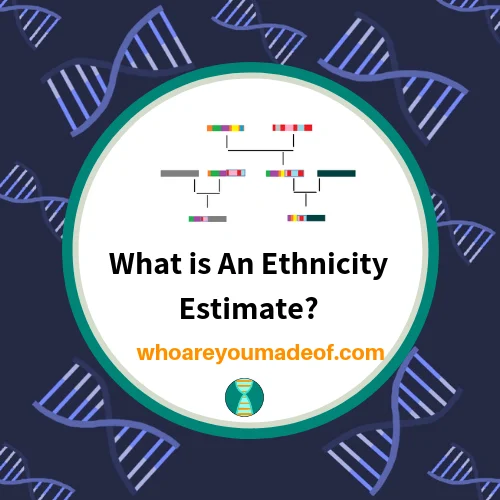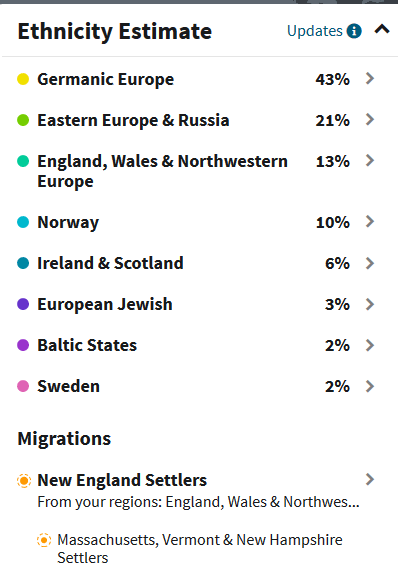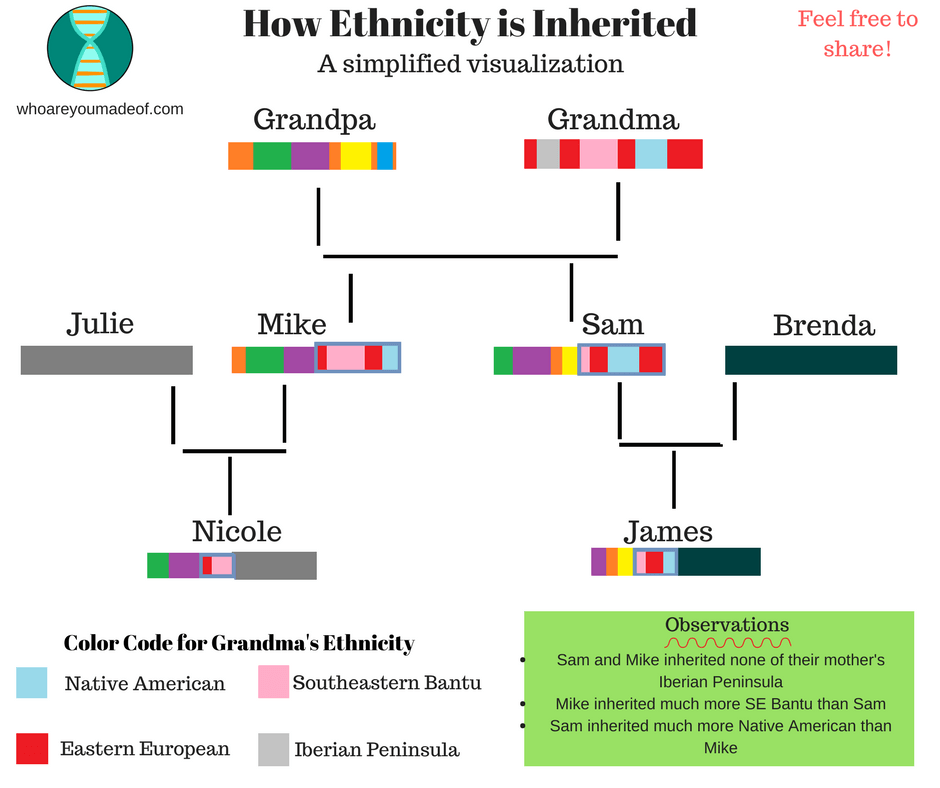Whether you are thinking about doing a DNA test, or have already done a test and are wondering about your results, one of your first questions might be about ethnicity estimates. What is an ethnicity estimate, anyway? And how does ethnicity get passed down?
In this post, you’ll learn:
- Exactly what an ethnicity estimate is
- How DNA testing companies are able to provide you with an ethnicity estimate
- How ethnicity is inherited

Ethnicity estimates, or ancestry composition reports, are the most popular reason to do autosomal DNA testing. People hope for an entertaining and accurate window into their family’s past, and it’s amazing that we can have this with a simple DNA test.
What is an ethnicity estimate?
An ethnicity estimate, ancestry composition report, or ancestry breakdown report, provides you with an approximation of which regions of the world most closely match your DNA.
In the image below, you can see my own ethnicity estimate from Ancestry DNA. Ancestry DNA’s high-tech computer algorithm based on advanced research has estimated that most of my DNA matches the Germanic Europe, Eastern Europe and Russia, and the England, Wales & Northwestern Europe DNA regions.

Does this mean that all of my ancestors came from these regions? Most definitely not, as my ethnicity estimate is not a complete report of where all of my ancestors lived.
An ethnicity estimate can only tell you information about the DNA that you did inherit from your ancestors and can tell you nothing about the DNA that you did not inherit. (Read more on this in the last part of this post)
What is an ethnicity estimate NOT?
Even though ethnicity estimates are super cool and fun, and sometimes even helpful, there are a few things that they are NOT.
An ethnicity estimate is not:
- Taken from your family tree. In fact, it will rarely match your known ancestry exactly.
- A way to determine paternity – our parents will often have ethnicity regions that surprise us, or not have the percentage breakdowns that we would expect based n what we know of their ancestry.
- 100% accurate. DNA testing companies strive for as much accuracy as possible, but it’s always important to remember that they are called estimates for a reason.
How do they get your ethnicity from your DNA?
Every human is almost identical from the perspective of the total amount of DNA that we all share with each other. Even so, there are exceptionally small (and otherwise insignificant) ways in which humans are genetically distinct.
DNA companies are able to detect and understand these minute differences in order to determine, among other things, where many of our ancestors may have lived over the past several hundred years.
(Did you notice that I said “many of our ancestors”? Read more on that in the next section)
By collecting reference samples from dozens of regions around the world, DNA testing companies are able profile the characteristics of DNA from the varying regions and create preference panels which they then compare with your DNA.
They use specially designed algorithms to determine which regions match your DNA most closely.
As with anything in life, the better the input, the better the output. When it comes to ethnicity estimates, large and high-quality sample populations, quality testing techniques, and nuanced regions (and sub-regions) lead to more accurate ancestry estimates.
How is ethnicity inherited?
The way DNA gets passed down is pretty interesting, but it causes a lot of confusion. Lack of understanding about how DNA is inherited is the main reason that ethnicity estimates are perceived to be inaccurate- or worse.
We inherit DNA from our parents in long DNA segments. These long DNA segments are made of up shorter segments inherited from the parents, grandparents, great-grandparents, and other more distant ancestors of our parents.
It is these DNA segments that provide clues about where our ancestors may have lived.
The problem is that we don’t inherit 100% of our parents’ DNA – we only get about 50% of it. To make matters more complicated, the 50% that inherit is randomly selected, and we have no way to know which of our parents’ DNA we inherited and which we didn’t.

The end result is that we only show ethnicity information in an estimate about our ancestry based on the limited amount of DNA that we got from our parents.
When you consider that our parents only inherited some of their parents DNA, and our grandparents only inherited some of our great-grandparent’s DNA (and so on and so on), it’s easy to understand how an ethnicity estimate couldn’t possibly be a comprehensive mirror-image of our family tree.
To illustrate this, take my own ethnicity estimate as an example. My paternal grandmother is 95% England, Wales, and Northwestern Europe and 5% Ireland and Scotland. If you look at my results, you’ll see that I only inherited 13% of the England, Wales, and Northwestern Europe ethnicity region (my dad was 49%) – much less than the 25% that I would have assumed I’d inherit.
While we can learn a lot from our ethnicity estimates, the best way to really know about our ancestors is to build a family tree using our DNA matches and ethnicity estimates as a guide. I recommend building a family tree on Ancestry (check out this post about how to do it: How to build a tree on Ancestry)
Do you want to test your DNA?
If you haven’t yet tested your DNA and you think you are ready to start this exciting adventure, I would definitely recommend that you check out my post called “Beginner’s Guide to DNA Testing” – I give you all of the knowledge you need to make a decision about which test to get.
Conclusion
I hope that this post has given you some insight about one of the most popular aspects of DNA results: ethnicity estimates.
If you have any questions about something that you read in this post, would like to share your perspective on your ethnicity estimate, or are on the fence about testing, I would love to hear from you in the discussion below.
Thanks for being here today.

